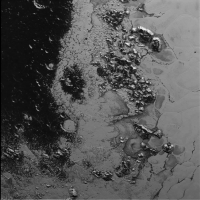Jul 21 2015
From The Space Library
NASA’s New Horizons Finds Second Mountain Range in Pluto’s ‘Heart’
 Image Credit: NASA/JHUAPL/SWRI
Image Credit: NASA/JHUAPL/SWRI
A newly discovered mountain range lies near the southwestern margin of Pluto’s Tombaugh Regio (Tombaugh Region), situated between bright, icy plains and dark, heavily-cratered terrain. This image was acquired by New Horizons’ Long Range Reconnaissance Imager (LORRI) on July 14, 2015 from a distance of 48,000 miles (77,000 kilometers) and sent back to Earth on July 20. Features as small as a half-mile (1 kilometer) across are visible.
Pluto’s icy mountains have company. NASA’s New Horizons mission has discovered a new, apparently less lofty mountain range on the lower-left edge of Pluto’s best known feature, the bright, heart-shaped region named Tombaugh Regio (Tombaugh Region).
These newly-discovered frozen peaks are estimated to be one-half mile to one mile (1-1.5 kilometers) high, about the same height as the United States’ Appalachian Mountains. The Norgay Montes (Norgay Mountains) discovered by New Horizons on July 15 more closely approximate the height of the taller Rocky Mountains.
The new range is just west of the region within Pluto’s heart called Sputnik Planum (Sputnik Plain). The peaks lie some 68 miles (110 kilometers) northwest of Norgay Montes.
This newest image further illustrates the remarkably well-defined topography along the western edge of Tombaugh Regio.
“There is a pronounced difference in texture between the younger, frozen plains to the east and the dark, heavily-cratered terrain to the west,” said Jeff Moore, leader of the New Horizons Geology, Geophysics and Imaging Team (GGI) at NASA’s Ames Research Center in Moffett Field, California. “There’s a complex interaction going on between the bright and the dark materials that we’re still trying to understand.”
While Sputnik Planum is believed to be relatively young in geological terms – perhaps less than 100 million years old - the darker region probably dates back billions of years. Moore notes that the bright, sediment-like material appears to be filling in old craters (for example, the bright circular feature to the lower left of center).
This image was acquired by the Long Range Reconnaissance Imager (LORRI) on July 14 from a distance of 48,000 miles (77,000 kilometers) and sent back to Earth on July 20. Features as small as a half-mile (1 kilometer) across are visible. The names of features on Pluto have all been given on an informal basis by the New Horizons team.
Release M15-112 NASA Views Complex World: New Horizons Pluto Science Update Set for July 24
Members of NASA’s New Horizons team will hold a science update at 2 p.m. EDT Friday, July 24, to reveal new images and discuss latest science results from the spacecraft’s historic July 14 flight through the Pluto system.
The briefing will be held in the James E. Webb Auditorium at NASA Headquarters, located at 300 E St. SW in Washington. NASA Television and the agency's website will carry the briefing live.
The briefing participants are:
- Jim Green, director of Planetary Science at NASA Headquarters
- Alan Stern, New Horizons principal investigator at Southwest Research Institute (SwRI) in Boulder, Colorado
- Michael Summers, New Horizons co-investigator at George Mason University in Fairfax, Virginia
- William McKinnon, New Horizons co-investigator at Washington University in St. Louis
- Cathy Olkin, New Horizons deputy project scientist at SwRI
Media may ask questions by telephone. To participate by phone, reporters must send an email providing their name, affiliation and telephone number to Felicia Chou at felicia.chou@nasa.gov by noon Friday. Media and the public also may ask questions during the briefing on Twitter using the hashtag #askNASA.
